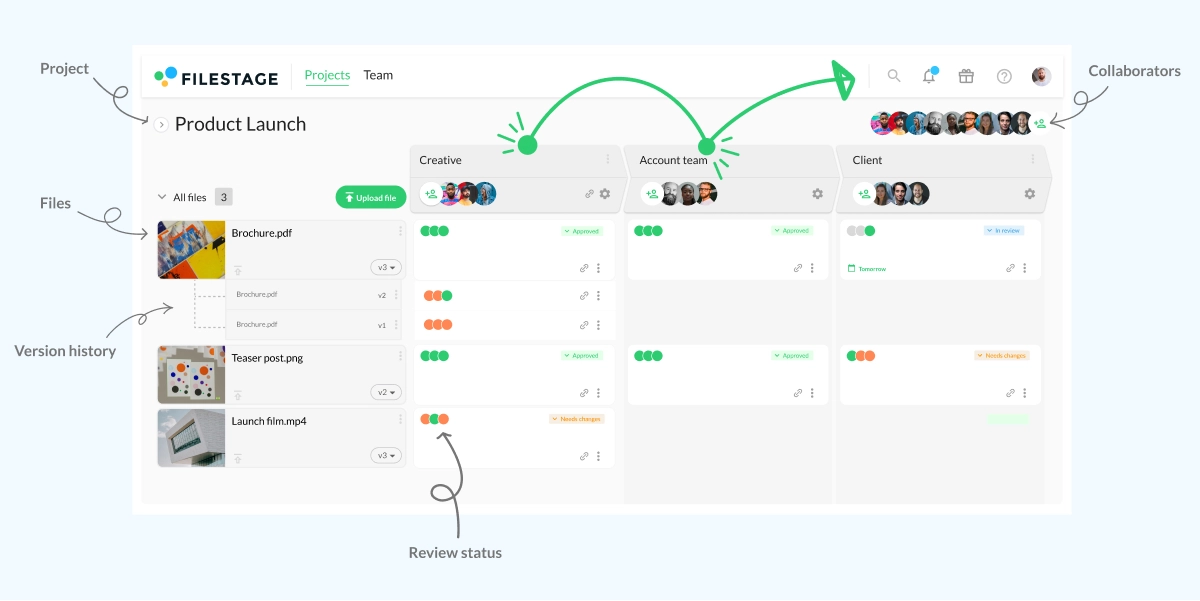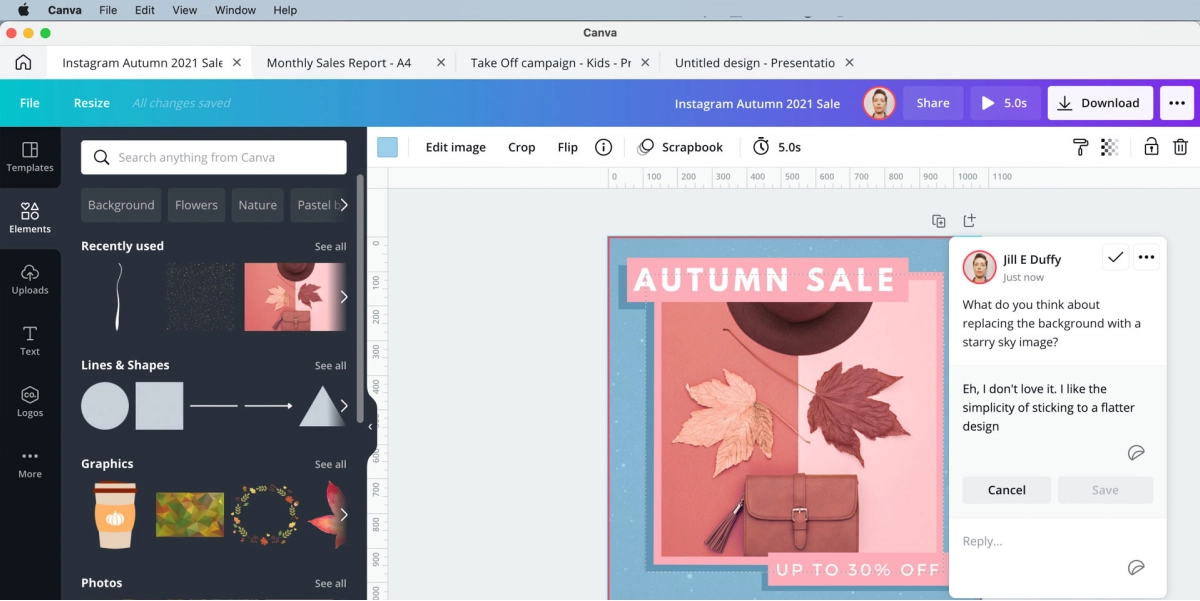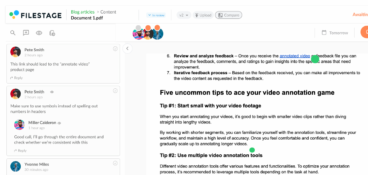It’s obvious now that remote work is here to stay – even if only for a few days a week or month. Both employees and employers across the globe found ways to stay home and work successfully.
But a remote-friendly world can only exist if we embrace powerful collaboration tools designed to make our lives easier. And the same goes for marketing teams. Since the pandemic, teams have turned to marketing collaboration tools to make their workflow faster and more organized.
So let’s see what’s considered a marketing collaboration tool and which ones your team should rely on to stay connected in a remote-friendly world.
What is marketing collaboration software?
Marketing collaboration software is a tool that helps marketing departments collaborate internally and externally. These tools are about managing projects and the creative process, as well as approving content.
With marketing collaboration tools, teams can monitor, change and proofread all their content. On top of that, marketing workflow software helps you work together and track the progress of all the tasks to push projects across the finish line faster.
Three ways marketing collaboration software benefits modern teams
Collaboration tools do so many things for marketing teams that it’s almost hard to put all those benefits into words. From making engaging and interactive virtual brainstorming sessions to faster approval processes and everything in between.
Having tools like Trello, Asana, or Filestage specializing in entirely different content production areas and integrating them makes collaboration tools so powerful for optimizing marketing processes.
Here are some of the most important benefits of marketing collaboration tools:
- More transparent communication
- Less reliance on meetings
- Easier access to information
To learn more about the benefits of marketing collaboration tools and how they help you overcome some major “productivity killers”, check out the video.
1. More transparent communication
One small mistake, like hitting the “reply” button instead of “reply all,” can spiral into some big transparency issues when handling your marketing production process over email.
To never worry if everyone who needs to be involved in the process is added to the email chain, you can add all colleagues or clients as collaborators in your marketing collaboration tools.
This way, all necessary information will be shared with all stakeholders at all times. Most importantly, you’ll make sure to avoid the horror of publishing content without the required approvals.
2. Less reliance on meetings
Think of all the meetings you need to host or attend when working on a single marketing campaign or project. With marketing collaboration software, you can free up your schedule from pointless meetings and focus on creating your best work.
Here’s a workflow you can create to speedup your content creation and approval with less meetings:
- Create a task in Asana and all important subtasks to carry the project, and assign them to all creators.
- Organize brainstorming sessions in Miro for your content and design teams to agree on the vision for the project.
- Regularly check in with your teammates over Slack to make sure everyone is OK with the workload and understands the brief.
- Use Figma so everyone can be up to speed with the designs.
- Have copywriters and designers upload all versions of their creative in Filestage and collect everyone’s feedback on top of their work.
- Use Filestage for the final approval of the project.
This way, you’ll avoid numerous rounds of meetings without compromising the team’s speed and efficiency in carrying out the project.
3. Easier access to information
One of the most important benefits of using marketing collaboration tools is having easier access to all information regarding the project. Since all collaboration platforms are held in the cloud, their main characteristics are shareability and easy access.
In most cases, the project creator needs to invite collaborators to the project by sending a link or an email invitation. This prevents you from ever having those small heart attacks where you cannot find files on your laptop and once again improves the level of collaboration.
Eight marketing collaboration tools to keep your team connected
There’s a range of marketing collaboration tools designed for different projects and stages of content creation. To make your process as smooth as possible, it’s best to know which tool will do magic for which use case and connect more than one tool if your budget allows it.
Here are eight marketing collaboration tools that’ll keep your team connected:
1. Filestage – best for feedback management
Filestage helps you create a seamless marketing approval process by allowing you to manage feedback and get sign-off on a project effortlessly. You can invite as many people as you like to review your designs, and you’ll get all feedback in one place.
Your teammates or clients can see what others have suggested and leave feedback in various ways – depending on how they prefer to express themselves.
Here’s how Filestage helps you get faster approval on marketing projects:
- Create review steps (with due dates) for each stage of your project and invite different stakeholders to different steps
- Share and review video files, designs, documents, websites, and all your other content
- Leave in-context comments and visual annotations, and add attachments
- Turn comments into a to-do list, so your team has a clear picture of what needs amending
- Keep track of the project status using the project dashboard and see who’s left to review the designs

2. Trello – best for coordinating content creation
Trello is a content management platform that helps teams seamlessly coordinate content creation, editing, and production. The tool is designed to streamline projects from start to finish with a clear overview of already created assets versus ones that still need to be produced.
Here’s where Trello works best:
- Managing media assets for social media
- Content planning for a blog
- Planning topics and managing assets for a newsletter
Marketing teams need to consistently create numerous assets for social media, blog, newsletter, and events. With Trello, they have a clear overview of all ideas, topics, and their statuses in a nicely designed content calendar that helps streamline the process of continuous assets production.
3. Asana – best for managing your marketing projects
Asana is a great tool for helping marketing teams organize, track, and manage their work. It makes it simple to plan workflows and projects with clear deadlines. You can even assign tasks and subtasks to different collaborators to keep your team on schedule at every step – from start to finish.
Here’s how Asana helps your team plan and execute marketing projects:
- Plan and structure your projects in a way that works best for you
- Assign tasks and set priorities and deadlines
- Track your projects and tasks to completion

4. Typeform – best for running surveys
Typeform specializes in online form building and online surveys. The platform is known for its user-friendly forms that help marketing teams generate valuable responses.
Here’s what Typeform is best for:
- Gathering data for an infographic
- Incorporating different types of media to bring questions to life while collecting teammate and client feedback
- Collecting and collating data to get actionable insights from your customer feedback

5. Miro – best for virtual brainstorming sessions
Miro is a creative collaboration platform that allows you to brainstorm with your team in real-time. No matter where you and your teammates are in the world, this online whiteboard tool helps bring all of you together and create everything you need to develop successful campaigns.
Here’s how Miro helps you set up amazing marketing campaigns:
- Compile research and find out how to gather information and understand your customer.
- Set goals and check out how you can map your whole campaign in one place.
- Create a brief to align teammates and build campaign consistency.
- Build journey maps to see how you can streamline processes for impactful launches.

6. Figma – best for collaborating on designs and prototypes
Figma allows design and marketing teams to work together, no matter where you all are in the world. You and your teammates can co-design at the same time, and your colleagues from marketing will see changes and comments appear immediately for flawless collaboration.
Here’s how Figma supports collaboration between marketing and design:
- Collaborate from anywhere on any device
- Add in-context comments and tag your teammates for clear communication
- View version history, so nothing gets lost

7. Canva – best for collaborating on print materials
If you’re working on a print brochure, packaging, or another type of content for print, then Canva is the right collaboration tool. It allows you to create professional designs without any designing knowledge – and they’ll even print them for you.
Here’s how to use Canva for successful marketing projects:
- Invite team members, allocate tasks, and publish or share, all from one place
- Have everyone leave feedback with real-time comments and reactions
- Track your team’s progress with the insights function

8. Webflow – best for no-code designs
With Webflow, you can take advantage of everything that HTML5, CSS3, and Javascript have to offer without writing a single line of code.
This helps marketing teams align their web with brand guidelines and optimize it for conversion. On top of that, you can work collaboratively with other teams with an easy handover process.
Webflow’s key features for successful collaboration:
- Ability to see in real time what others are working on within your project
- Hand design control over to your teammates

Four ways Filestage helps marketing teams collaborate
Filestage is a collaborative feedback and approval platform that helps you create a seamless approval process. No matter where you or your teammates are located, with Filestage, you’ll always receive your feedback and approval in time.
Here are four ways Filestage helps teams collaborate:
1. Share your work with reviewers
First and foremost, Filestage makes it easy for you to share your work with all important stakeholders. Do you need your teammates to take a look at your work? Or maybe you have a client that needs to review and approve all content?
Think about everyone who should be involved in the project and invite them as reviewers in a few simple clicks.
Having a centralized place to share your work and get feedback right on top of it will speed up the content collaboration and make the whole process more enjoyable.
2. Collect feedback and discuss ideas for improvements
When you collect feedback without a marketing collaboration tool, the whole thing can turn into a bit of a mess. But with content approval and markup software like Filestage, life gets a whole lot easier.
Your reviewers can open the file at any moment and leave comments for everyone else in the process to see in real time. They can discuss the feedback and ideas right on top of the work while resolving conflicts. This will result in you knowing exactly what changes to make.
3. Create and share a new version
When you deal with multiple review rounds and have a sea of comments to work with, it’s easy to get lost in all improvements that have already been made. And that goes for both you and your reviewers.
Here’s how Filestage helps you and your team stay more organized:
- Tick off comments as you go along and manage all feedback successfully
- Share as many versions as you need with your reviewers and always have a clear overview of changes made in the file
4. Repeat until you get approval from everyone
You can repeat the steps of getting feedback and resubmitting the newest version of your work for review up until you receive approval. In Filestage, you’ll know that the work still needs improvements if you see an orange dot at the end of a review.
Once all your reviewers give you the green light in Filestage, your work is approved and ready for the publishing phase!
Final thoughts
More and more teams are working in a remote environment, and collaboration tools are making it happen for them. For marketing teams, things are no different. Many teams are turning to marketing collaboration tools to successfully guide their content creation from start to finish. See what makes Filestage your go-to tool for marketing collaboration and start a free trial →










